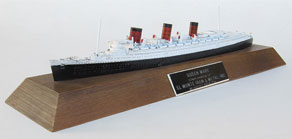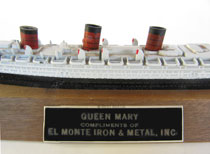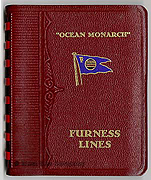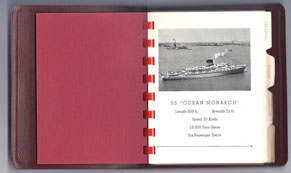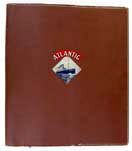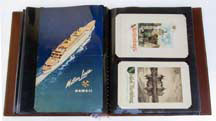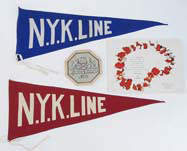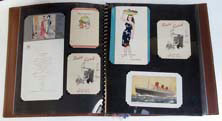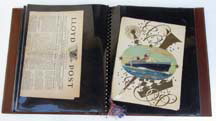West Sea
Company
OCEAN LINER
Catalog Page 17

When no price is shown, use  button to request the price.
button to request the price.
Click on photos for larger images.
Click
 for ordering details.
for ordering details.

|
|
17.12 FAMOUS LINER POSTCARD.
Genuine pre-World War II postcard from the very
famous grand English line RMS AQUITANIA. The
magnificent vessel is depicted in a starboard bow view
steaming out to sea with a tug, seaplane and sailboat
dwarfed in its wake. It is signed on the bottom in
script Cunard White Star Aquitania. The reverse bears
a brief hand-written message and is franked with a one pence
stamp with the image of soon-to-be King George VI postmarked
SOUTHAMPTON PAOUEBOT 4 MAY 1937. 3 ½ by 5 ½
inches. Perfectly
preserved.
19
RMS AQUITANIA was built by John Brown & Company in
Clydebank, Scotland and launched almost a year to the day of
the sinking of her near sister ship RMS TITANIC. AQUITQNIA
was launched on April 21, 1913 and sailed on her maiden
voyage to New York on May 30, 1914. AQUITANIA was the
third in the Cunard Line's "grand trio" of express liners,
preceded by the RMS MAURETAINIA and RMS LUSITANIA, and was
the last surviving four funnel ocean liner. Widely
considered one of the most attractive ships of her time,
AQUITANIA earned the nickname "Ship Beautiful."
Ultimately she was scrapped in Scotland in 1950.
In her 36 years of service, AQUITANIA served military duty
in both world wars and was returned to passenger service
after each. AQUITANIAs record for the longest service career
of any 20th century liner stood until 2004, when RMS QUEEN
ELIZABETH II became the longest-serving liner with a career
of 40 years.
Interestingly King George VI was crowned King of England on
May 12, 1937, exactly one week after this postcard was
sent. The currently reigning monarch, Queen Elizabeth,
is his daughter.
|

|

|
|
17.13 OCEAN LINER MODEL. Period
miniature commemorative of the famous ocean going liner the
RMS QUEEN MARY. This detailed model is faithfully cast out
of metal in high relief depicting the major details of the
ship including funnels, ventilators, deck equipment and
lifeboats. In was then hand painted in red, white and black
to accentuate those details. It is mounted on a solid
hardwood plinth bearing the engraved presentation plaque
reading “QUEEN MARY Compliments of El Monte Iron &
Metal, Inc.” The entire presentation measures nearly 1
foot long by 3 inches wide. The ship itself measures just
over 10 inches long. Excellent original condition. A very
nice presentation for desk or library shelf. 179
Construction of the ship known only as "Yard Number 534",
began on December 19, 1930 by the John Brown Shipbuilding
Company in Clydebank, Scotland. Under ownership of the
Cunard Lines the ship was ultimately launched 3 ½ years
later with the name QUEEN MARY on September 26,1934. Named
after Queen Mary, the consort of King George V, her name was
a closely guarded secret up until her launch.
RMS QUEEN MARY sailed on her maiden voyage from
Southampton on May 27, 1936. In August of that year she
captured the Blue Riband for Atlantic crossings from her
rival the lovely French liner NORMANDIE, with average speeds
of 30.1 knots westbound and 30.6 knots eastbound. She
retained the prize until 1952 when the SS UNITED STATES
surpassed those speeds.
Early in September 1939 QUEEN MARY steamed out of
Southampton for New York. But by the time she arrived war in
Europe had erupted and she was ordered to remain in port
until further notice alongside the NORMANDIE. In 1940 QUEEN
MARY and NORMANDIE were joined by QUEEN MARY’s new
sister ship, QUEEN ELIZBETH, fresh from her secret dash from
the Clydebank. There, the three largest liners in the world
sat idle for some time until the Allied commanders decided
that they should be used as troopships.
QUEEN MARY departed for Sydney, Australia where she and
several other liners were converted into troopships.
Eventually joined by QUEEN ELIZABETH, they were the largest
and fastest troopships involved in the war, often carrying
as many as 15,000 men on a single voyage.
On October 2, 1942, QUEEN MARY sank one of her escorts,
cutting through the light cruiser HMS CURACOA off the Irish
coast. Due to the ever present threat of U-Boat attacks, her
captain was under strict orders not to stop for any reason.
So the remaining Naval escorts in company were ordered to
rescue survivors. As a result the accident cost 338
lives.
During the war, the QUEEN MARY carried British Prime
Minister Sir Winston Churchill several times. On those
voyages the Prime Minister insisted on having his lifeboat
equipped with a machine gun in order to "resist capture at
all costs".
After the war QUEEN MARY was refitted for passenger
service, which she resumed in 1947. QUEEN MARY and QUEEN
ELIZABETH continued to dominate the transatlantic passenger
trade well into the 1950s. But when transatlantic passenger
jet service began in 1958 the golden era of the “Cunard
Queens” came to an end. Beset by age, inefficiency and
public apathy, Cunard was finally forced to remove the grand
liners from service. QUEEN MARY was retired in 1967 and
QUEEN ELIZABETH was withdrawn in 1968. Ultimately the city
of Long Beach, California outbid Japanese scrap merchants
and QUEEN MARY was saved. Hoping for a similar fate a team
of investors purchased QUEEN ELIZABETH for an attraction in
Port Everglades, Florida. However the venture did not work
out and she was sold to a Hong Kong businessman.
Unfortunately before she could be fully restored she caught
fire and sank in 1972.
|

|
17.62 CRUISE
BOOKLET. Original mid-1900’s
booklet provided to passengers of the S.S. OCEAN MONARCH of
the Furness Lines. This cruise memento is bound in
faux leather and opens to the tile page depicting the OCEAN
MONARCH steaming in New York Harbor with the Statue of
Liberty in the background. It states ‘S.S. OCEAN
MONARCH Length 509 ft. Breadth 72 ft. Speed 20 knots, 15,000
Tons Gross, Six Passenger Decks.” The booklet is
then divided into sections with tabs marked “ITENERARY,
PEOPLE, RECORDS, PHOTOGRAPHS.” Unmarked except
for a single page. 4 ½ by 5 ¼ inches.
Outstanding original condition.
29
|


|
|
17.83 FAMOUS SHIP'S LIFERING.
Authentic ship's life ring from one of the most famous
passenger liners in history, the French Line's SS
LIBERTÉ as
boldly stenciled on the top front. This classic lifering is
of standard old world construction having a solid cork core
overlaid by heavy hand-stitched sail canvas and rimmed with
a hemp rope grab line. The back of the ring is stamped
"Bouee 75 Liege Homologation 55 ES Anciens Etd., Labbe,
Nantse." 29 inches in diameter. Excellent original condition
showing a few scuff marks and a couple of small holes in the
fabric, as expected. 795

The SS EUROPA (renamed SS
LIBERTÉ ) was
one of two fast ocean liners built by Blohm & Voss
shipyard, Hamburg, Germany in the late 1920's for the
Norddeutscher Lloyd Line (NDL) to ply the transatlantic
passenger service. EUROPA was launched August 1, 1928
and made her maiden voyage to New York on March 19, 1930.
She was a vessel of 936.7 feet in length displacing 49,746
gross tons. Her four steam turbines generated 105,000 shaft
horse power propelling her to a speed of 27 1/2 knots. She
had a passenger capacity of 860 first class, 500 second
class, 305 tourist class, 617 third class and a total crew
of 965.
During the early years of World War
II EUROPA, in German hands, was largely inactive. She
was captured by the Allies in 1944 and subsequently pressed
into service as a troopship. After the war she was turned
over to the French as a reparation of war. In 1946, while
being refitted for passenger service in Le Harve, France,
she snapped her moorings during a storm, drifted into the
wreck of the PARIS and sank. She was refloated and
work continued. In 1950 she made her maiden voyage to New
York under her new name, SS
LIBERTÉ.
After nearly 10 years of service she was finally retired in
1958, laid up in 1961 and scrapped in 1962.
|


|
17.11 FAMOUS LINER PHOTO.
Original sepia tone silver print of the S.S. MORRO CASTLE
ASHORE AT ASBURY PK. N.J.” as written along the bottom
in the photographer’s own hand. It is signed
lower left “Cole & Co Asbury Pk NJ.”
5
postpaid
The S.S. MORRO CASTLE was a luxury liner built by the
Newport News Shipbuilding & Drydock Company for the Ward
Lines, running between New York City and Havana, Cuba. The
MORRO CASTLE was named for the fortress that guards
the entrance to Havana Harbor. She was launched in
March 1930 and embarked on her maiden voyage on August 23,
1930.
In the early morning hours of Saturday, September 8th, 1934,
en route from Havana to New York, the ship caught fire and
burned, killing a total of 137 passengers and crew.
She eventually ran aground on the beach near Asbury Park,
New Jersey and remained there for several months before she
was towed away and sold for scrap.
The devastating fire aboard MORRO CASTLE provided
the incentive for improved shipboard fire safety.
In modern cruise ships, the use of fire
retardant materials, automatic fire doors, fire alarms, fire
drills and better crew training are all a direct result of
the MORRO CASTLE incident.
|

|

|
|
17.10 HOUSE FLAG. Mint
condition post war house flag of the Pacific Mail Line,
depicting a California bear, a Hawaiian palm tree and the
initials “PML.” This brilliant flag was
made by the Paramount Flag Company of San Francisco as
marked on the canvas hoist end. A full length sisal
line with eyelets on each end is sewn into the hoist.
The various segments of the flag are double-stitched
individual panels (not stenciled). It measures 4 by 6
feet and is in factory new condition. A very handsome,
displayable relic from America’s golden age of
shipping.
149
Shortly after the Mexican War, Congress passed the Mail
Steamer Bill in 1847 authorizing mail to be sent from
America’s East Coast to the West Coast by steamship.
Just 2 years later, the discovery of gold in California
unleashed a demand for ocean travel never before seen in
this country. Under that backdrop the Pacific Mail
Steam Ship Company was formed in 1848. The venerable
San Francisco-based line continued to operate until 1925,
when it was acquired by the Dollar Line, also of San
Francisco. When the government bailed out the Dollar
Line in 1938, ownership passed to American President
Lines. By that time PMSS only existed on paper.
It formally closed in 1949 after a century of
service.
|

|
17.07 OCEAN LINER SCRAPBOOK.
Large, early 1900’s compilation of ephemera
relating to ocean liner travel from the 1920’s through
1965. This leather cover scrapbook is filled with
original old ocean liner memorabilia. The famous lines
represented include Cunard White Star, Norwegian Caribbean
Lines, N.Y.K. Lines, White Star Line, United States Lines,
Matson Lines, Hamburg-Amerika Line and Nordeutscher
Lloyd. Items consist of menus, tickets, on board
entertainment programs, post cards, drink coaster,
stationary, passenger lists, maps and on board news.
Also included are two souvenir cloth pennants from the
N.Y.K. Lines. Of significant note are the presence of
several items relating to the R.M.S. QUEEN MARY and
the S.S. UNITED STATES. Large size, 17 by 11
inches and 3 inches thick. Excellent, very well
preserved condition. At least 72 original individual
items at less than $5 each!
349
|
|
|
|
|
|
|
MATSON
|
PENNANTS
|
QUEEN MARY
|
UNITED STATES
|
17.29 EARLY LINER TRADE CARD. Rare,
second half of the 19th century ocean liner trade card advertising
the "Royal and United States Mail Steamers WHITE STAR LINE" as
printed on banners surrounding a large 4-masted steam/sail ship with
two funnels. This beautifully chronomlithographed advertising flier
is printed on a heavy stock card measuring 3 1/2 by 5 1/2 inches. The
reverse is printed with much information extolling the virtues of the
company's fleet, entitled in part: "The Splendid Steamers of the
WHITE STAR LINE Sailing Weekly Between Liverpool and New York, Are
all, without exception among the largest and fastest of Ocean
Steamers..." Card is in excellent condition noting some toning to the
back and just a tiny loss on one corner.
149
This rare card was issued more than a
quarter century before the appearance of the most
famous liner in the White Star fleet -- indeed the most famous liner
of all time -- the RMS TITANIC!

|
|
REVERSE
|

17.94 FAMOUS OCEAN LINER KEYCHAIN.
Lovely, original high relief keychain struck in the form of a
silvered bronze medal to commemorate the
"LIBERTÉ" as
embossed on the obverse. The medal depicts a port quarter view of the
magnificent liner above which is written "Compagnie
Général
Transatlantic." Below the vessel name is written, "LeHarve, New York,
French Line." The reverse bears the lovely semi-nude depiction of
Liberty, having broken the bonds of chains. She stands in a conch
shell flanked by stylized dolphins on either side. The medal is
attached to a chain and locking clip for holding keys. The rim of the
medal is hallmarked and it measures 1 1/4 inch in diameter. The
overall size of the keychain is 3 inches. Excellent condition showing
wear from actual use.
95

|

|

|

|
|
REVERSE
|
LIBERTY
|
SHIP
|
SHIP
|

17.92 GLASS ASHTRAY. Thick molded
glass ashtray with the boldly stenciled name "CUNARD" on the bottom.
6 inches in diameter and 1 1/4 inches thick. Perfect condition.
59
The famous Cunard Line can trace its history
all the way back to 1838 when shipping magnate Samual Cunard and
others formed the British and North American Royal Mail Steam Packet
Company. Cunard faced many competitors from Britain, France, the
United States and Germany, but survived them all. This was mainly due
to a great focus on safety. Cunard ships were not the largest nor the
fastest but they earned a reputation for being the most reliable and
the safest. The prosperous company eventually absorbed Cunard's
principal competitor, the White Star Line, owners of the ill-fated
RMS TITANIC and the HMHS BRITANNIC.
For more than a century and a half, Cunard
dominated the Atlantic passenger trade and was one of the world's
most important companies, with the majority of their liners being
built at the John Brown Shipyard in Clydebank, Scotland. Today the
Line still operates two classic passenger liners the RMS QUEEN
ELIZABETH II and the RMS QUEEN MARY II.

17.90 LINER ASHTRAY. Hard fired
porcelain ashtray from the Norwegian Lines Steamship Company. The
ashtray bears the Norwegian national ensign in the center rimmed by
complementing colors. The bottom is marked with an anchor flanked by
the letters "PP" above the number "55." Perfect condition. 4 3/8ths
inches in diameter.
49
Norwegian America Line (Den Norske
Amerikalinje), was a cruise ship line founded in 1910. Originally an
operator of passenger and cargo ships, the company ran regular
transatlantic service between Norway and the United states and later
to East Africa. The establishment of the Norwegian America Line was a
the statement of Norway's "maritime independence" following the
dissolution of its union with Sweden in 1905. In 1971 the company
discontinued transatlantic passenger service.

|
|
BOTTOM
|

17.87 PORCELAIN ASHTRAY. Hard fired
porcelain ashtry bearing the logo NAC (Norwegain-American Cruise
Lines). This diminutive ashtray has 18 raised nibs on its periphery
to hold cigarettes. The bottom is signed and dated "Porsgrund, Norway
1980" with an anchor. 3 12/ inches in diameter. Perfect condition.
39
The company was founded as Norwegian
Caribbean Lines in 1966 by Knut Kloster and Ted Arison with just one
830-ton cruise ship offering low cost Carribean cruises. Arison soon
left to form Carnival Cruise Lines, while Kloster acquired additional
ships for Caribbean service. NCL pioneered many firsts in the cruise
industry and was responsible for many of the cruise innovations that
have now become standard throughout the industry.
NCL made headlines with the acquisition of
the FRANCE in 1979, rebuilding the liner as a cruise ship and
renaming her NORWAY. At that time the NORWAY was
significantly bigger than any other cruise ship, and exploited the
extra space available by adding a large variety of onboard
entertainment. Her success paved the way for a new era of giant
cruise ships.

|
|
BOTTOM
|

17.85 IDENTIFIED LINER ASHTRAY. Heavy
cast glass ocean liner ashtray bearing the charming logo of King
Neptune with his long, flowing beard and trident above the script,
"Matson Lines's". Surrounding Neptune are the names of the famous
liners, "MATSONIA, MARIPOSA, MONTEREY, and LURLINE." 3 1/2 inches
across. Perfect condition.
59
Matson Navigation Company's long association
with Hawaii began in 1882, when Captain William Matson sailed his
three-masted cargo schooner EMMA CLAUDINA from San Francisco
to Hilo, Hawaii. Increased commerce brought a corresponding interest
in Hawaii as a tourist attraction. Captain Matson expanded his fleet
and by 1908 established passenger service to and from the mainland.
The decade from the mid-20s to mid-30s marked a significant period of
Matson expansion. In 1925, the Company established Matson Terminals,
Inc., a subsidiary to perform stevedoring and terminal services for
its fleet. With increasing passenger traffic to Hawaii, Matson added
the S.S. MALOLO in 1927. Its success led to the construction
of the liners MARIPOSA, MONTEREY and LURLINE between
1930 and 1932.
Immediately after the December 7, 1941
attack on Pearl Harbor, the passenger liners MARIPOSA, MATSONIA,
MONTEREY and LURLINE, and 33 Matson freighters were called
into military service. The four passenger liners completed a wartime
total of 119 voyages, covered 1 1/2 million miles and carried a total
of 736,000 troops.
By 1956, as with most of the other
transoceanic passenger lines, Matson left the passenger
transportation business in favor of ocean freight, specifically
container ships. The company still operates today.

17.84 SHIP WHEEL ASHTRAY. Solid,
shiny metallic aluminum ashtray in the form of a classic 8-spoke
ship's wheel. The center of the ashtray is inlaid with a large copper
disc bearing the colorful cloissoné
houseflag of the British India Steam
Navigation Company below which is a banner reading "NEVASA." 6 inches
in diameter and in good, used condition.
89
The twin screw, quadruple expansion steam
propelled passenger ship NEVASA was built by Barclay Curle
& Company in Glasgow, Scotland for the British India Steam
Navigation Company Glasgow & London. She was a steel hull vessel
480 1/2 feet in length of 9071 gross registered tons. Launched late
in 1912, the same year as theTITANIC disaster, NEVASA
began her maiden voyage on March 22, 1913 from London to Calcutta.
When the Great War broke out she was taken over as a troopship in
1914, then used as a hospital ship between 1915 and 1918. In 1919 she
reverted to being a troop ship. In 1925 she was permanently rebuilt
as a troopship. Used again for that purpose in World War II, she
resumed commercial service after the War, but that was still in a
chartered status, transporting troops home. She was scrapped in
1948.

|
|
BOTTOM
|
17.70 CRUISE TROPHY. High quality, silverplate loving cup
with applied, high relief brass emblem reading "Awarded on
Holland-America Line Cruises" depicting the line's house flag. This
handsome cruise memento is said to have come from the famous pre-War
liner NIEUW AMSTERDAM. It stands 6 1/2 inches tall and
slightly more than 5 1/2 inches wide. Excellent original condition.
195
The Nederlands-Amerikaansche Stoomvaart-Maatschappij, popularly
known as the Holland-American Line, was founded in 1873 and based in
Rotterdam, The Netherlands. Neutral registry in World War I brought
large profits to the company and it was in a position to expand.
However American immigration restrictions following the War delayed
construction of the company's flagship the NIEUW AMSTERDAM
until 1938. When the Germans invaded Holland in May of 1940, they
seized the OLENDAM while the STATEMDAM was destroyed in
the fighting. The remainder of the company's fleet was chartered by
the Allies for the war effort. The NIEUW AMESTERDAM in
particular had a spectacular war career, performing troop carrying
duties throughout the world until her triumphant return to her home
port in April 1946.

17.34 POSTER FRAGMENTS. Authentic early 1930's advertising
poster for the "Compagnie Generale Transatlantique" touting their
famous liners the ILE de FRANCE, the FRANCE, and the
PARIS. These two parts of one larger poster were found sealed
behind yet another later steamship poster as backing material and
have not seen the light of day in over 60 years! They are perfect!
The only problem is that they have been cut! Nevertheless, they are
wonderful, identifiable examples of the lithographer's art, of the
art deco period, and pre-date the famous liner NORMANDIE .
Over $2,000 if in tact! 49
for the two!

17.30 TRADE CARD. Finely engraved
19th century American advertising trade card for the "National Line
Steamships" with the colorful depiction of the clipper bowed S.S.
ENGLAND under sail, flanked by a rope border emblazoned with
flags of the United States and Britain. The reverse boasts "National
Line, Passenger Steamship comprising twelve of the largest Ocean
Steam Ships belonging to one company in the Atlantic Service..." Much
information including a listing of of "Passage Rates" for which 1st
Class Excursion is $120! The front of the card is signed "Hatch Lith.
Co., NY" and measures 3 1/2 x 6 inches. Good condition with toning to
the reverse and minor staining. Circa 1885.
195

|
|
REVERSE
|

7.47 REFERENCE BOOK. Frederick
Emmons, "The Atlantic Liners," 1977, Bonanza Book, New York. 160
pages including an Index of Ships. This hardcover book with dust
jacket covers the major liners of the world that plied the Atlantic
from 1925 through 1970. It is organized by country, and then by
Steamship company, with a history of each company given. The
remainder of the book is dedicated to detailed information on the
ships themselves. Each entry provides a line drawn profile view along
with a paragraph on the ship's characteristics, service history, and
ultimate fate. An invaluable research tool!
39

2.14 CRUISE MEMENTO MODEL.
Genuine passenger ship cruise trophy from the famous
American President Lines cargo/passenger liner the "S. S. PRESIDENT
CLEVELAND" as identified in embossed letters below the model of the
ship. This good likeness is formed of heavy cast metal done with
faithful detail. It is faced by an engraved brass plaque reading “ACHIEVEMENT”
and flanked by the embossed inscription “ACHIEVEMENT.”
Excellent overall condition with a good age patina. 8 1/2 inches long
by 2 1/2 inches wide. A very displayable and handsome authentic
model. 69
The steam cargo/passenger ship SS
PRESIDENT CLEVLAND was a P2 design ship built in 1947 by
Bethlehem Shipbuilding Co., Alameda California, Hull No. 9509.
She had a length of 609 feet, a draft of 30 feet, displaced 23,404
tons and had a cruising speed of 20 knots. Designed to carry
379 First Class passengers and 200 economy, she also boasted a cargo
capacity of 193,984 cubic feet. Homeported in San Francisco,
the CLEVELAND along with her sister ship the PRESIDENT
WILSON reestablished America’s preeminence in the
passenger trade between the West Coast and the Orient. But in
1973, with passenger liner service no longer profitable, American
President Lines sold the ship. It was scrapped a year
later.

|
|
BACK
|

2.15 CRUISE MEMENTO MODEL. Genuine
passenger ship cruise trophy from the famous American President Lines
cargo/passenger liner the "S. S. PRESIDENT ROOSEVELT" as identified
in embossed letters below the model of the ship. This good likeness
is formed of heavy cast metal done with faithful detail. It is faced
by a brass plaque engraved "BRIDGE.". Excellent overall condition
with good age patina and surface oxidation to the metal. 8 ½
inches long by 2 ½ inches wide. A very displayable and handsome
authentic model. 69
Originally built in 1944 as the 18,920 ton
Hawaiian Steamship Company's LEILANI the ship was purchased
by the American President Lines in 1960 and renamed S.S.
PRESIDENT ROOSEVELT. After an extensive refit in Seattle, the
ship began service between the West Coast of the U.S and the Orient.
Sold in 1970.

|
|
BACK
|

© 1998-2014 West Sea Co. All
rights reserved.
![]() for ordering details.
for ordering details.


